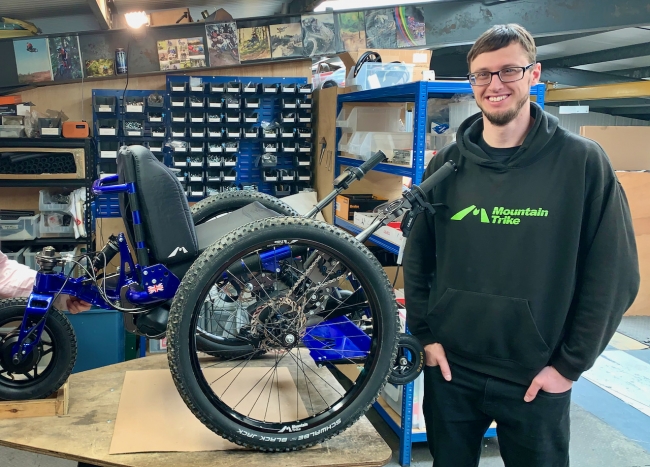4 minute read • published in partnership with Flowlens
Case Study: How the Mountain Trike Company supported growth with new systems
The Mountain Trike Company was founded in 2011 by managing director, engineer, designer and mountain biking enthusiast, Tim Morgan. As part of a University project, Tim saw an opportunity to invent an all-terrain wheelchair, giving the thrill and experience of mountain biking to people with mobility challenges. Early demand was strong, and the company was born to satisfy it.
Having experienced steady growth and with new product lines creating additional pressures on the business processes, the company decided the time was right to invest in new systems.

Growth and new products meant the Mountain Trike Company had to invest in new systems / Picture: Mountain Trike Company
Increased demand and a need for new systems
With design and production based in Nantwich, and sales and marketing run out of Bath, the Mountain Trike team was used to operating remotely, even before the pandemic. However, this involved several standalone systems and processes that relied too heavily on just one person. Spreadsheets were the glue that held things together, and updates were manually posted to the Sage accounts package on a weekly basis.
Critically for Tim, with increased demand and a new electrically-assisted Mountain Trike range in the offing, time was in short supply. The manual nature of the processes meant that Tim and the team spent a lot of time in the office, checking paperwork, moving orders through different stages, responding to customer queries and keeping on top of current production activities and stock levels. Team members also voiced concerns about duplicating effort and overly laborious processes that could be streamlined.
“We had our admin and production systems, spread across various different platforms, there was no cohesive link to bring them all together. A few of our processes were too manual, a few were too reliant on individual’s memories. It wasn’t easy for people to dip in and out of a project so I wanted something to bring everything under one roof.”
Stock management
Stock management was a key factor in deciding to look at systems. Maintaining stock levels and ensuring orders were placed for longer lead time items was becoming more challenging with the additional sales volume and new product line. This, and the ability to manage a customer order from initial enquiry through to order, production and stock was the critical requirement. Cloud was also a must-have requirement, to facilitate the distributed working structure of the company.
“We’d just launched a new electric assist model, which boosted our sales and broadened our market and I knew that would put more demands on the business. It was vital that the system we chose was capable of dealing with that growth, giving us the tools to cope with higher volumes, so my vision was one system that drives everyone’s activity every day, and very easily takes the customer through the stages of the order process, and give us that long term structure.”
For Tim, reducing the dependency on any one individual was also important, something that was clearly highlighted by the pandemic. “The pandemic has emphasised how important it is to have an efficient system where someone might be away for a month and pick things up again. It makes you think… what if something happened to me – my staff would need to be able to deal with things. You realise your system needs to run itself, it can’t be reliant on an individual’s input, knowledge or memory. It should be easy to follow and efficient, so other staff members can step if someone is away or off, including myself.”

Established in 2011, the Mountain Trike Company manufacture all-terrain wheelchairs / Picture: Mountain Trike Company
Integrated approach
Tim chose Flowlens to meet The Mountain Trike Company’s requirement, with it’s integrated approach to CRM, stock management, MRP, production and after sales.
The new system also replaced a standalone CRM, and has worked in streamlining the everyday processes for sales interactions, setting follow-ups and creating quotations. Sales cycles at The Mountain Trike Company can often take months, so it has been easier to stay on top of follow-ups and dip into information when it’s needed.
“We were used to quite a lengthy process – in general, the feeling you get in your day to day job, you know this is quicker than before. I’ve got all the parts and descriptions to add to quotations, when the customer places the order, it’s just the click of a button – we’re definitely seeing that it helps. It’s helped our end of year stocktake as well.”
What’s next? “We’re in the process of switching to Xero accounts, as we’ve just been through our year end, so the next step will be to get that connected to Flowlens.”
For companies considering a digital transformation process, Tim advises taking a big step back from the day to day to understand what the business needs.
“Actually try and explain your processes to someone who doesn’t know the business, and you’ll find how ridiculous they are, where the gaps are, and where tasks take too much time. This step back will help you analyse what you do already, and see what your requirements are from a new system.”
